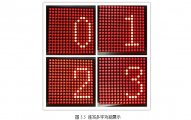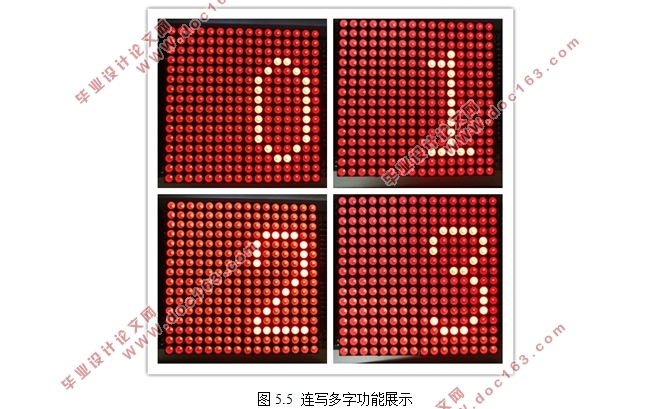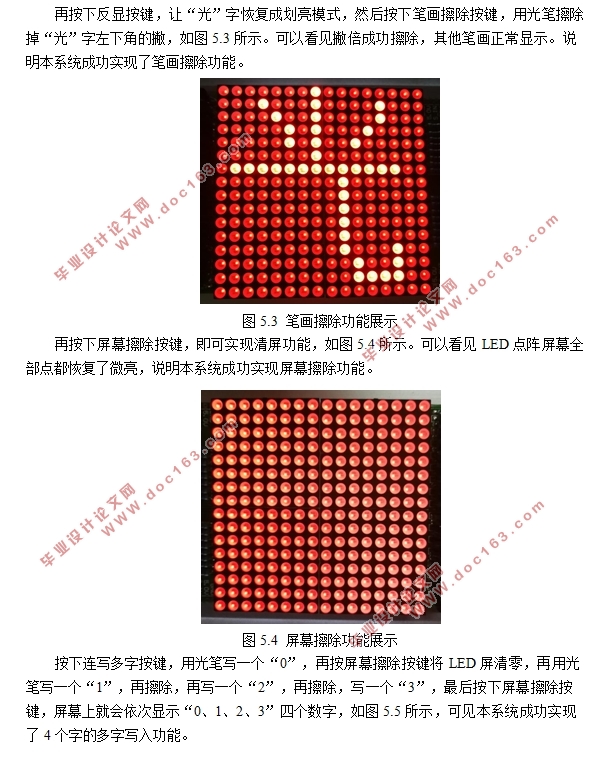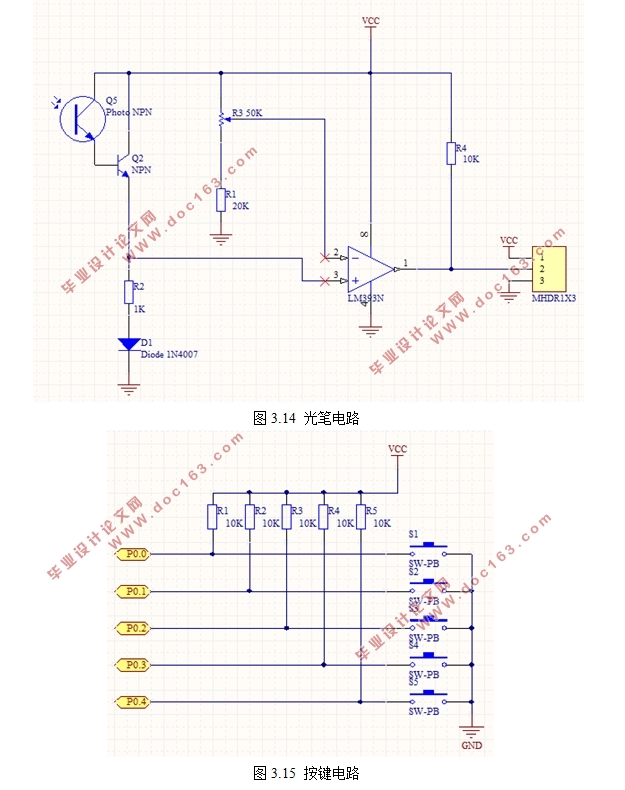基于单片机的LED点阵书写显示屏的设计

基于单片机的LED点阵书写显示屏的设计(任务书,开题报告,外文翻译,论文14000字)
摘 要
本毕业设计的研究内容是基于单片机的LED点阵书写显示屏的设计及制作。该研究课题的系统硬件部分主要由单片机最小系统模块、16*16LED点阵模块、点阵驱动电路模块、独立按键电路模块、光笔电路模块组成。软件部分利用KEIL U VISION4软件编译环境,运用单片机C语言编写程序来实现手写屏的划亮,反显,擦除,连写多字等多种功能。
这篇论文详细的介绍了系统的设计方案论证、硬件部分原理说明、软件部分原理及流程说明以及结果分析。本设计采用STC12C5A60S2单片机为控制核心,以及经典的74LS138+74HC595芯片驱动LED点阵方案,使用3DU33光敏三极管制作光笔,使用独立按键来实现功能的选择。在硬件方面系统的原理较为简单,实现起来较为容易,软件方面采用了单片机C语言,程序结构清晰易读。总的来说设计的比较符合要求,实物制作也比较顺利。
关键词:单片机;LED点阵;C语言;光笔
Abstract
The research content of this graduation design is the design and production of LED dot matrix writing screen based on single-chip microcomputer. The system hardware of this research project is mainly composed of the minimum system of the single-chip microcomputer, 16*16 LED dot matrix, dot matrix drive circuit, independent key circuit, and light pen circuit. The software uses the KEIL U VISION4 software to compile the environment, uses the one-chip computer C language to write the program to realize the writing screen's bright, the reverse display, the erasing, writes many characters and so on many kinds of functions. [来源:http://www.doc163.com]
This paper introduced in detail the design of the system proposal, the hardware part of the principle description, software part of the principle and process description and result analysis. This design uses STC12C5A60S2 microcontroller as the control core, and the classic 74LS138+74HC595 chip driver LED dot matrix program, use 3DU33 phototransistor to make light pen, use independent keys to achieve the function of choice. In terms of hardware, the principle of the system is relatively simple and easy to implement. The software uses a single-chip microcomputer C language, and the program structure is clear and easy to read. In general, the design is more in line with the requirements, and physical production is also relatively smooth.
Key Words:SCM; LED dot matrix; C language; light pen




目录
第1章 绪论 1
1.1 研究课题的背景 1 [版权所有:http://DOC163.com]
1.1.1 写字板的发展背景 1
1.1.2 单片机的发展背景 2
1.2 研究课题的意义 3
第2章 系统方案的确定 5
2.1 单片机系统的确定 5
2.2点阵驱动方案的确定 5
2.3显示方案的确定 6
2.4光笔方案的确定 6
第3章 系统硬件设计 8
3.1系统硬件总体设计 8
3.2单片机最小系统设计 8
3.2.1 单片机引脚图 8
3.2.2 时钟电路 8
3.2.3 复位电路 9
3.2.4 EA/VPP引脚 10
3.2.5 P0端口 10
3.3LED点阵设计 10
3.4LED点阵驱动电路设计 12
3.5光笔电路设计 15
3.6按键电路设计 15
第4章 系统软件设计 17
4.1 编译环境介绍 17
4.2 系统总体流程设计 18 [版权所有:http://DOC163.com]
4.3 LED点阵扫描函数设计 18
4.4 按键扫描函数设计 21
4.5 光笔中断函数设计 21
4.6 功能函数设计 22
4.6.1 划亮函数设计 22
4.6.2 反显函数设计 23
4.6.3 屏幕擦除函数设计 23
4.6.4 笔画擦除函数设计 24
4.6.5 连写多字函数设计 24
第5章 总结 26
5.1 结果分析 26
5.2 总结与体会 28
参考文献 30
致谢 31 [来源:http://Doc163.com]
